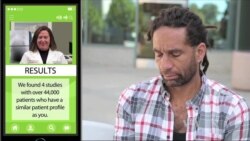Add on-demand medical care to the growing list of what your cellphone can do for you.
The University of Southern California Center for Body Computing says it uses virtual reality technology and artificial intelligence to provide specialized care for patients anywhere in the world.
The face of cardiologist Leslie Saxon, the executive director of the University of Southern California's Center for Body Computing, is being used to create a virtual doctor.
"There are only so many experts in the world and we're never going to be able to bring the world's medical experts or have enough to supply the need of the entire world,” Saxon said. “So we can clone, if you will, many of the experts to provide care anywhere anytime, without borders, so that I can treat patients in Iran or Indonesia or India as easily as I can treat them in Los Angeles for 90 percent of the issues that come up."
The birthplace of Saxon's avatar is University of Southern California's Institute for Creative Technologies (USC ICT).
Virtual vs. actual
With cameras and computers, researchers at USC ICT have been able to capture Saxon's face and create virtual humans that not only can interact with real people, but respond with empathy, said Randall Hill, executive director of USC ICT.
"We can pick up signals there that tell us whether the patient is depressed or happy or whatever," he said. "And so we're able to use that and create an experience — talk to the virtual human where the virtual human is able to mirror certain types of things and be able to react to the emotions in the moment."
In many ways, virtual doctors can be better doctors than their human originals, Saxon said.
"We're human doctors," she said. "We're not always in the same mood. We're not always delivering information in the same way. We're not always as current as we need to be depending on the type of visit that we're having. So these virtual humans hopefully are smarter potentially; they even read the patients better."
How it works
The virtual doctor will have the knowledge of its human counterpart to diagnose problems and provide tailored information about the diagnosis based on patients' characteristics and where they live.
Sensors on a phone or worn by the user can provide more information to the virtual doctor.
An avatar like this doesn't replace real doctors — it enhances them, Hill said.
"We really view what we're doing as extending the reach of real doctors and taking care of commonplace question answering, interviewing that does not necessarily require the deep expertise that real doctors have, but can take care of all that part before you have the interaction with the real doctor," he said.
The Virtual Care Clinic can raise the standard of medical care globally, according to Saxon.
"We can bring everything that's built in developed countries — sophisticated medical systems and knowledge — across the world where they are not built,” Saxon said. “So that, hopefully, we save so much cost and gain so much understanding in this process that we create kind of an equalization of care across the world, so that more money could be spent on innovation."
The mobile application for the Virtual Care Clinic will be available later this year. The aim is to eventually have virtual doctors that can speak in different languages to reach different communities.









